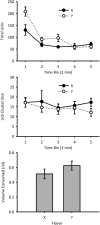Contexts control negative contrast and restrict the expression of flavor preference conditioning
- PMID: 26752234
- PMCID: PMC4708609
- DOI: 10.1037/xan0000091
Contexts control negative contrast and restrict the expression of flavor preference conditioning
Erratum in
-
"Contexts control negative contrast and restrict the expression of flavor preference conditioning": Correction to Austen and Sanderson (2016).J Exp Psychol Anim Learn Cogn. 2016 Jul;42(3):289. doi: 10.1037/xan0000105. J Exp Psychol Anim Learn Cogn. 2016. PMID: 27379719 Free PMC article.
Abstract
Consumption of a high concentration of sucrose can have either a detrimental, negative contrast effect or a facilitatory, preference conditioning effect on subsequent consumption of a low concentration of sucrose, depending on the cues that are present during consumption. The role of context and flavor cues in determining these effects were studied using analysis of the microstructure of licking in mice. Exposure to a high concentration followed by exposure to a low concentration resulted in a transient reduction in mean lick cluster size, which was context dependent (Experiment 1). However, there was no change in the total number of licks or overall consumption. When a flavor that had previously been paired with a high concentration was paired with a low concentration, there was an increase in the total number of licks, and overall consumption, but no change in the mean lick cluster size (Experiment 2). Pairing a high concentration with a flavor in a particular context before pairing the context and flavor compound with a low concentration resulted in abolishing the expression of the flavor preference conditioning effect on the total number of licks and consumption (Experiment 3). These results demonstrate that although context and flavor cues have dissociable effects on licking behavior, their interaction has an antagonistic effect on the behavioral expression of memory.
(c) 2016 APA, all rights reserved).
Figures



References
-
- Capaldi E., Sheffer J. D., & Pulley R. J. (1989). Contrast effects in flavour preference learning. The Quarterly Journal of Experimental Psychology B: Comparative and Physiological Psychology, 41, 307–323. - PubMed
-
- Capaldi E. D., Owens J., & Palmer K. A. (1994). Effects of food-deprivation on learning and expression of flavor preferences conditioned by saccharin or sucrose. Animal Learning & Behavior, 22, 173–180. 10.3758/BF03199917 - DOI
Publication types
MeSH terms
Substances
Grants and funding
LinkOut - more resources
Full Text Sources
Other Literature Sources

